Search Results
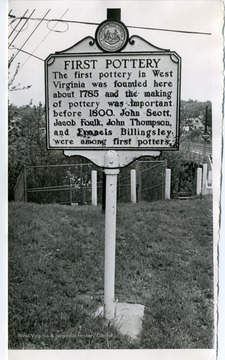
- IDNO:
- 031306
- Title:
- First Pottery Marker
- Description:
- 'The first pottery in West Virginia was founded here about 1785 and the making of pottery was important before 1800. John Scott, Jacob Foulk, John Thompson, and Francis Billingsley were among first potters.'
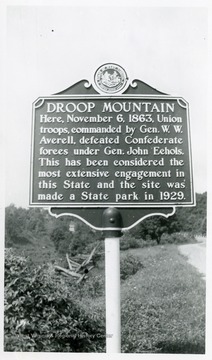
- IDNO:
- 031307
- Title:
- Droop Mountain Marker in Pocahontas County, W. Va.
- Date:
- 1952
- Description:
- The marker is on US Rt. 219: Here, November 6, 1863, Union troops, commanded by Gen. W. W. Averell, defeated Confederate forces under Gen. John Echols. This has been considered the most extensive engagement in this State and the site was made a State park in 1929.

- IDNO:
- 031308
- Title:
- West Virginia Historic Marker Between Monterey, Va. and Durbin, W. Va.
- Date:
- 1952
- Description:
- 'West Virginia was long a part of Virginia. Morgan Morgan began the settlement of the region in 1727. A great battle with the Indians took place at Point Pleasant, 1774. West Virginia became a separate state of the Union in 1863.'
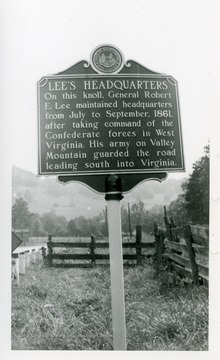
- IDNO:
- 031309
- Title:
- Lee's Headquarters Marker on U. S. Route 219, Linwood, W. Va.
- Date:
- 1952
- Description:
- 'On this knoll, General Robert E. Lee maintained headquarters from July to September, 1861 after taking command of the Confederate forces in West Virginia. His army on Valley Mountain guarded the road leading south into Virginia,' The maker stands on US 219 in Linwood in Pocahontas Co.
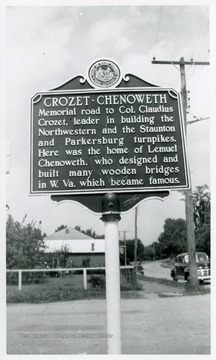
- IDNO:
- 031310
- Title:
- Crozet-Chenoweth Marker at Beverly, W. Va.
- Date:
- 1952
- Description:
- 'Memorial road to Col. Claudius Crozet, leader in building the Northwestern and the Staunton and Parkersburg turnpikes. Here was the home of Lemuel Chenoweth, who designed and built many wooden bridges in W. Va. which became famous.'
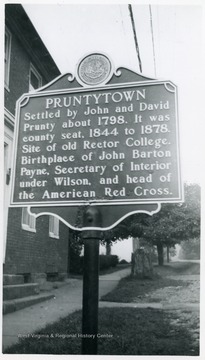
- IDNO:
- 031311
- Title:
- Pruntytown Marker on U. S. Route 50 at Pruntytown, W. Va.
- Date:
- 1951
- Description:
- Pruntytown: Settled by John and David Prunty about 1798. It was county seat 1844 to 1878, Site of old Rector College, Birthplace of John Barton Payne, Secretary of Interior under Wilson, and head of the American Red Cross.
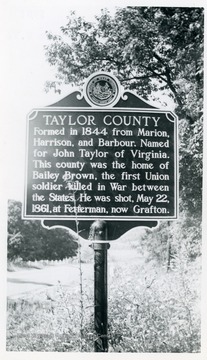
- IDNO:
- 031312
- Title:
- Taylor County Marker on U. S. Route 119, between Morgantown and Grafton, W. Va.
- Date:
- 1951
- Description:
- Taylor County: Formed in 1844 from Marion, Harrison, and Barbour. Named for John Taylor of Virginia. This county was the home of Bailey Brown, the first Union soldier killed in War between the States. He was shot, May 22, 1861, at Ferterman, now Grafton.
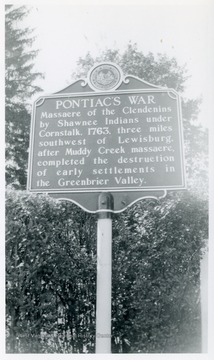
- IDNO:
- 031313
- Title:
- Pontiac's War Marker, Greenbrier County, W. Va.
- Date:
- 1952
- Description:
- Pontiac's War: Massacre of the Clendenins by Shawnee Indians under Cornstalk. 1763, three miles southwest of Lewisburg after Muddy Creek massacre, completed the destruction of early settlements in the Greenbrier Valley.

- IDNO:
- 031314
- Title:
- Terra Alta Marker, Preston County, W. Va.
- Date:
- 1952
- Description:
- Terra Alta: Half a mile high Famed as a health resort resort. Once known as Cranberry for extensive cranberry glades found near. North is Cranesville Swamp, noted for its wild life. In that vicinity, Lewis Wetzel killed several Indians.
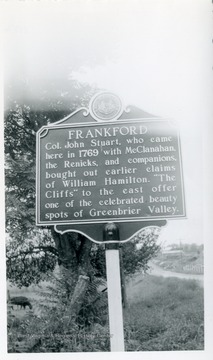
- IDNO:
- 031315
- Title:
- Frankford Marker, Greenbrier County, W. Va.
- Date:
- 1952
- Description:
- Frankford: Col. John Stuart, who came here in 1769 with McClanahan, the Renicks, and companions bought out earlier claims of William Hamilton. "The Cliffs" to the east offer one of the celebrated beauty spots of Greenbrier Valley.

- IDNO:
- 031316
- Title:
- Col. John Stuart Marker, Greenbrier County, W. Va.
- Date:
- 1952
- Description:
- Col. John Stuart: Col John Stuart built Stuart Manor, 1789, near Fort Stuart. He was a military and civil leader and led a company in the Battle of Point Pleasant. As clerk of Greenbrier County, he left many historic records. His first office is standing.
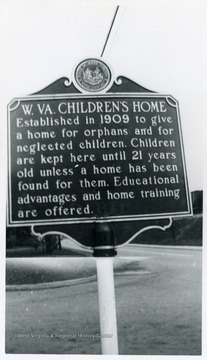
- IDNO:
- 031317
- Title:
- W. Va. Children's Home Marker on U. S. Route 219 between Elkins and Montrose, W. Va.
- Date:
- 1951
- Description:
- W. Va. Children's Home: Established in 1909 to give a home for orphans and for neglected children. Children are kept here until 21 years old unless a home has been found for them. Educational advantages and home training are offered.











